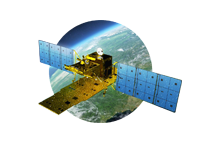JAXA/EORC are regularly conducting the calibration and validation of the PALSAR-2 and its standard products using the data over the calibration sites in the world. This page reports evaluation results of the PALSAR-2 standard products and radiometric calibration factors to convert digital number to backscatter value.
| Jan. 26, 2021: |
| Jan. 12, 2021: |
|
| Oct. 17, 2019: |
|
| Nov. 26, 2018: |
| Aug. 9, 2018: |
|
| Mar. 24, 2017: |
| Oct. 19, 2016: |
|
- Report ver. 2021.01.08 (PDF file, 980KB)
- Report ver. 2019.10.15 (PDF file, 856KB)
- Report ver. 2018.08.07 (PDF file, 859KB)
- Report ver. 2016.10.19 (PDF file, 490KB)
- Report ver. 2014.11.20 (Initial calibration results)
Digital number in the PALSAR-2 JAXA standard product is converted to backscattering coefficient (sigma naught, sigma zero) using the following equations:
-

- (for L1.5, L2.1)
-

- (for L1.1)
σ0: Backscattering coefficient (Sigma naught or Sigma zero) [unit: dB]
DN: Digital number (or raw pixel value)
CF1, A: Calibration factor [unit: dB]
| Calibration factor | Value [dB] |
|---|---|
| CF1 | -83.0 |
| A | 32.0 |
- Calibration factors (CF1 and A) for the previous version of processing software
>> Here (PDF file, 22KB)
- * Version of the PALSAR-2 processing software can be checked in "PALSAR-2 Product Processing Software Release Note" on the AUIG-2 top page after registered user log-in or in the field No.12 of the file descriptor records of each CEOS file.
(Update: Oct. 1, 2019)
| Title | Content |
|---|---|
| Usage limitation of ScanSAR mode products due to the modification of burst control timing on February 8, 2015. | When using ScanSAR mode products observed before February 7, 2015, interferometry processing is possible only during some observation periods. Reference:“Effective data for interferometric analysis with PALSAR-2 ScanSAR mode” (see “Information” in the AUIG2 login page) https://www.eorc.jaxa.jp/ALOS-2/ en/calval/ScanSAR_Burst_Overlap_20151127_e.pdf |
| Usage limitation of Stripmap [10 m] mode (beam F2-6) products due to the center frequency modification on June 1, 2015. | ① Interferometry between the beam F2-6 and ScanSAR mode is not possible for the observation before May 31, 2015. ② Interferometry of beam F2-6 images before and after changing center frequency on June 1, 2015 is not possible. Reference: “Change of the center frequency for Stripmap Fine 10-m mode (F2-6)” (see “Information” in the AUIG2 login page) https://www.eorc.jaxa.jp/ALOS-2/ en/calval/AUIG2_CenterFrequency_20151127_e.pdf |
| Image quality degradation of due to the modification of attenuator (ATT) setting for ScanSAR mode. | ScanSAR cross-polarization images observed before ATT setting modification on April 11, 2018
sometimes become dark and/or blurred over low backscattering areas (e.g., ocean). Reference: “Change of SAR attenuator setting for ScanSAR cross-polarization mode” (PDF file, 325KB) https://www.eorc.jaxa.jp/ALOS-2/ en/calval/PALSAR2_ScanSAR_ATT_change_201808.pdf |
| Degradation of radiometric and geometric performance due to ionospheric effects | Variations in the total electron content (TEC) can change the backscatter coefficient and pixel position.
When comparing images from two separate periods, the backscatter coefficient and pixel position may deviate
from the general accuracy range. Reference: ”Isoguchi et al. (2019). Effect of Faraday Rotation on L-Band Ocean Normalized Radar Cross Section and Wind Speed Detection. IEEE Journal of Selected Topics in Applied Earth Observations and Remote Sensing.” |
| Image quality degradation due to radio frequency interference (RFI) from the ground | RFI is removed in the standard product processing of JAXA, but when RFI is very strong,
it may not be completely removed and appeared as noise on the image. Reference: ”Natsuaki et al. (2017). An autocorrelation-based radio frequency interference detection and removal method in azimuth-frequency domain for SAR image. IEEE Journal of Selected Topics in Applied Earth Observations and Remote Sensing.” |
- T. Motohka, O. Isoguchi, M. Sakashita, and M. Shimada, "RESULTS OF ALOS-2 PALSAR-2 CALIBRATION AND VALIDATION AFTER 3 YEARS OF OPERATION", IGARSS 2018, Jul. 25, 2018.
- T. Motohka, O. Isoguchi, M. Sakashita, and M. Shimada, "ALOS-2 PALSAR-2 Cal/Val Updates", JAXA/EORC Joint PI Meeting of Global Environment Observation Mission FY2017, Jan. 24, 2018. (PDF file, 2.3MB)
- M. Shimada, O. Isoguchi, T. Tadono, and K. Isono, "PALSAR Radiometric and Geometric Calibration", IEEE Trans. Geoscience and Remote Sensing, Vol. 47, No. 12, pp.3915-3932, Dec. 2009.
- M. Shimada, "Model-based Polarimetric SAR Calibration Method Using Forest and Surface-Scattering Targets", IEEE Trans. Geoscience and Remote Sensing, Vol. 49, No. 5, pp.1712-1733, May 2011.










